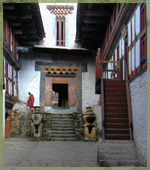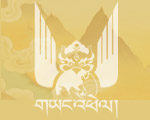 What
is immediately apparent on entering Bhutan is the clarity of
difference. The country was almost entirely isolated from the
more modern outside world until the early 1960s and has subsequently
undergone only very partial integration in line with the measured
and balanced development policy pursued. It is only one generation
removed from what might be termed a pre-modern condition, and
for many their overall situation - although considerably improved
in certain important respects - has not changed that dramatically.
The prevailing culture, therefore, not only draws on certain
aspects of the past for inspiration, but also bears an unusually
close resemblance to a long-established undiluted tradition.
Within this context neither the positions occupied by religion
and the monarchy, or the perpetuation of dress, architecture,
handicraft and overall social organization appear as particularly
outdated throwbacks. What
is immediately apparent on entering Bhutan is the clarity of
difference. The country was almost entirely isolated from the
more modern outside world until the early 1960s and has subsequently
undergone only very partial integration in line with the measured
and balanced development policy pursued. It is only one generation
removed from what might be termed a pre-modern condition, and
for many their overall situation - although considerably improved
in certain important respects - has not changed that dramatically.
The prevailing culture, therefore, not only draws on certain
aspects of the past for inspiration, but also bears an unusually
close resemblance to a long-established undiluted tradition.
Within this context neither the positions occupied by religion
and the monarchy, or the perpetuation of dress, architecture,
handicraft and overall social organization appear as particularly
outdated throwbacks.
There is a rare coherence and sense of balance in current
cultural conditions. Throughout the world pockets of indigenous
culture perpetuate. However, it is unusual that an entire
nation remains collectively so connected to its traditions,
and significant dislocations have not yet occurred across
time and space. Much of Bhutanese history retains direct contemporary
relevance, rather than being a record of a remote and incongruent
past. Furthermore, a complete division has not yet occurred
between modern urban and traditional rural cultural systems.
Individual identities remain firmly rooted within established
structures and belief systems, reflected in a lack of self-consciousness,
an underlying self-confidence and the high return rate of
students studying overseas.
The foundations of contemporary Bhutanese culture lie with
several closely interrelated traditional legacies: ethnicity,
Buddhism, hierarchy, community and self-sufficiency. There
are three main ethnic groups - the Sharchops of Indo-Mongoloid
origin, the Ngalops of Tibetan origin and the Lhotsams of
Nepali origin - and there remain a few distanced tribal communities.
The most profound cultural influences arrived with the Tibetan
migration. The Ngalops are the dominant group within the country,
over the centuries bringing with them Tibetan Buddhism, artistic
and more functional practices. The earlier settled Sharchops
were converted to Buddhism and subsequently integrated within
a centralized Ngalop dominated nation. The Lhotsams' arrival
is much more recent - over the course of the Twentieth Century
- and, due to Hindu religious belief, the relative strength
of an existing culture and their concentration in the south
of the country, many have not become wholly assimilated within
the prevailing Ngalop dominated national culture. Although
the national language is Dzongkha - belonging to the Tibetan
language family and historically spoken only in the west of
the country - Nepali (and to a lesser extent Sharchop) remain
widely spoken. The national newspaper, the Kuensel, represents
the major language sets, being published in Dzongkha, Nepali
and English, which has become a principal language of instruction.
Since its arrival in the Seventh Century and gradual diffusion,
Tantric Buddhism has underpinned individual and collective
outlooks. The relationship between religion and culture was
and remains particularly intimate due to the both the holistic
approach to life that Buddhism implies, and the enhanced significance
attributed to religion within traditional societies. In the
sense that Buddhism, especially in its tantric form, lays
out a blueprint for correct thoughts and actions (and therefore
correct values), it has strongly informed the development
of political and social institutions. There remains an unusual
consistency between respective elements of a supporting cultural
system. Furthermore, since the natural environment, art forms,
rituals and ceremonies are all connected to religion, Buddhism
has been the fundamental influence on material as well and
psychological aspects of culture.
Politics and religion remain deeply interrelated. Whereas
Bhutanese society is predominantly egalitarian, the legitimacy
to rule is divinely determined. This implies a very steep
natural hierarchy, with a significant division between those
to whom divine legitimacy has been attributed - high rinpoches,
the King and blood relations - and everyone else. Those in
authority possess an awareness of their responsibility and
the reciprocal nature of implied relationships. Around these
centers a system of court politics has developed, where power
is given through the nature of the relationship with the source.
This implies a very vertical and narrow central political
hierarchy. Although the political system is being reformed
- and new hierarchies are developing related to wealth and
more broad-based notions of status - power remains concentrated.
Other more aesthetic cultural forms are essentially passed
from the top-down, for example fashion and architectural style.
The basic social structure remains highly devolved. Scattered
self-reliant village communities were traditionally relatively
distanced from each other and monastic-fortress power bases.
This has led to highly localized and self-contained worldviews
and life-worlds. A restricted perspective on the material
world has served to accentuate a village's relationship with
itself and the spiritual domain. Local stories and superstitions
- many with fantastic themes and twists - thrive within a
rich storytelling tradition. Religious aspects are deeply
embodied within village systems, varying from a temple or
priest to an auspicious location and interesting explanation.
There remains an immense multiplicity and diversity of cultural
practice, concentrated around respective communities. A number
of local dialects are spoken and an integrated extended family
system remains firmly in place.
The idea of community remains extremely strong, being a robust
source of identity. Where everyone knows everyone else and
their personal histories, one is more likely to suffer from
claustrophobia than alienation. Even when transferred to an
urban environment - particularly among the majority first
and second-generation migrant - most people still associate
with a particular region and village, and a similar sense
of community has evolved within these new settlements. Traditional
values possess a high respect for age, history, local deity,
learning, face and family. The essential self-reliance of
individual villages underlies traditional economic systems
that were non-monetized, subsistence-based and internally
self-sufficient. It is no coincidence that communities with
a trading culture - for example the people of Laya and Chapcha
- have proved more successful at taking advantage of emerging
business opportunities.
|



